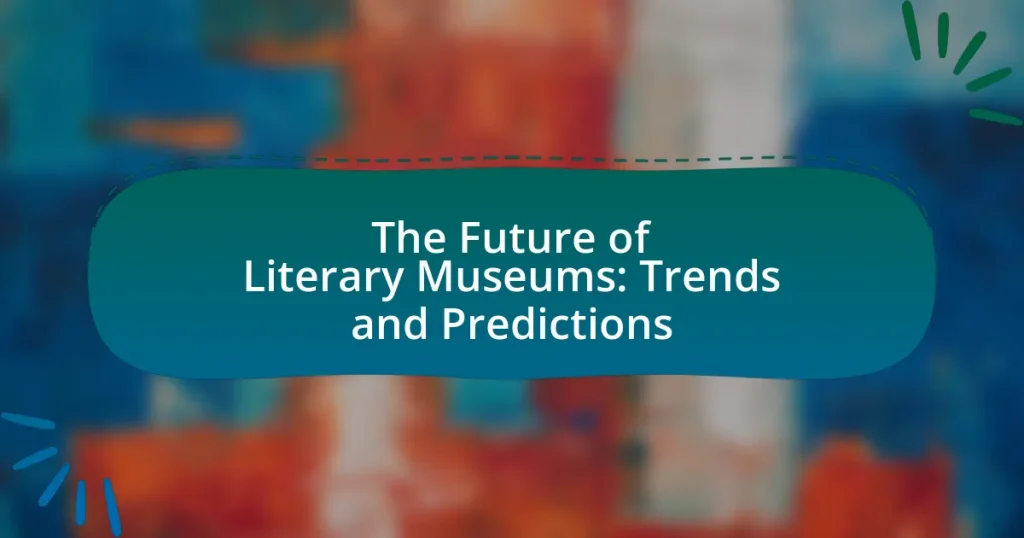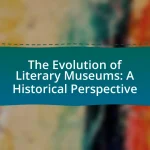The article focuses on the evolving landscape of literary museums, highlighting current trends and future predictions. Key trends include the integration of digital technology, such as virtual and augmented reality, to enhance visitor engagement and accessibility. The article discusses the shift towards inclusivity, showcasing diverse narratives and fostering community involvement through educational programs and collaborative events. Additionally, it examines the impact of technological advancements on visitor demographics, emphasizing the attraction of younger audiences through interactive experiences. The article concludes with insights on the challenges literary museums face and strategies for modernization to remain relevant in a rapidly changing cultural environment.
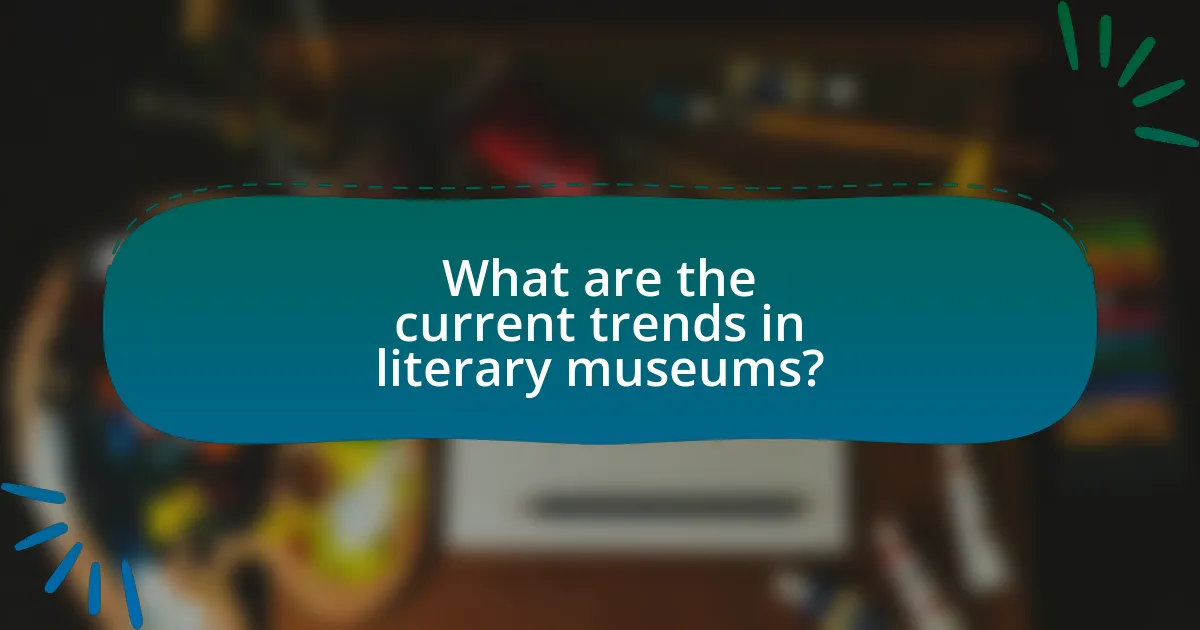
What are the current trends in literary museums?
Current trends in literary museums include the integration of digital technology, interactive exhibits, and community engagement initiatives. Literary museums are increasingly utilizing virtual reality and augmented reality to enhance visitor experiences, allowing them to immerse themselves in the literary worlds of authors. For instance, the British Library has implemented digital storytelling techniques to attract younger audiences. Additionally, many literary museums are focusing on inclusivity by showcasing diverse voices and narratives, reflecting a broader cultural representation. This trend is evident in institutions like the Langston Hughes House, which emphasizes African American literature and history. Furthermore, collaborations with local schools and community organizations are becoming common, fostering educational programs that connect literature with contemporary social issues. These trends indicate a shift towards making literary museums more accessible, relevant, and engaging for a wider audience.
How are technological advancements shaping literary museums?
Technological advancements are transforming literary museums by enhancing visitor engagement and expanding access to literary works. Digital tools such as virtual reality and augmented reality allow museums to create immersive experiences that bring literary history to life, enabling visitors to interact with exhibits in innovative ways. For instance, the British Library has implemented digital archives that provide online access to rare manuscripts, allowing a global audience to explore literary treasures without geographical limitations. Additionally, interactive displays and mobile applications facilitate deeper connections with the content, as seen in the use of QR codes that link to multimedia resources. These advancements not only enrich the educational experience but also attract a younger, tech-savvy audience, ensuring the relevance of literary museums in the digital age.
What role does virtual reality play in enhancing visitor experiences?
Virtual reality significantly enhances visitor experiences by providing immersive and interactive environments that engage users on a deeper level. This technology allows visitors to explore literary worlds and narratives in a way that traditional exhibits cannot, fostering a more profound emotional connection to the content. For instance, studies have shown that immersive experiences can increase retention of information by up to 75%, compared to 10% for traditional methods. By simulating environments from literary works, virtual reality not only captivates visitors but also encourages exploration and learning, making literary museums more dynamic and appealing.
How are digital archives transforming access to literary collections?
Digital archives are transforming access to literary collections by providing widespread, immediate availability of texts and related materials online. This shift allows users from diverse geographical locations to access rare manuscripts, historical documents, and literary works that were previously confined to physical libraries or archives. For instance, initiatives like Project Gutenberg and the Digital Public Library of America have digitized millions of texts, making them freely accessible to the public. Additionally, digital archives often include advanced search functionalities and metadata, enhancing the research experience and enabling users to discover connections between works that may not have been evident in traditional formats.
What shifts are occurring in visitor demographics and engagement?
Visitor demographics are shifting towards a younger, more diverse audience, with increased engagement driven by digital platforms and interactive experiences. Recent studies indicate that literary museums are attracting visitors aged 18-34, who represent a significant portion of the audience, compared to older demographics that previously dominated. Additionally, engagement metrics show that visitors are spending more time interacting with exhibits that incorporate technology, such as augmented reality and social media integration, which enhances their overall experience. This trend is supported by data from the American Alliance of Museums, which highlights that institutions embracing digital engagement strategies see a 30% increase in visitor interaction and satisfaction.
How are literary museums attracting younger audiences?
Literary museums are attracting younger audiences by incorporating interactive technology and engaging programming. These institutions utilize virtual reality experiences, mobile apps, and social media campaigns to create immersive environments that resonate with tech-savvy youth. For instance, the British Library has implemented augmented reality features in exhibitions, allowing visitors to interact with literary artifacts in innovative ways. Additionally, literary museums are hosting events like author talks, workshops, and themed nights that appeal to younger demographics, fostering a sense of community and relevance. This approach is supported by research indicating that 70% of millennials prefer experiences over material goods, highlighting the effectiveness of experiential learning in cultural institutions.
What strategies are being implemented to increase community involvement?
Literary museums are implementing strategies such as community workshops, collaborative events, and outreach programs to increase community involvement. These initiatives encourage local participation by providing hands-on experiences and fostering connections between the museum and the community. For example, workshops allow residents to engage with literary themes and create their own works, while collaborative events with local authors and schools promote a shared cultural experience. Additionally, outreach programs targeting underrepresented groups help to diversify the audience and enhance community representation within the museum’s activities.
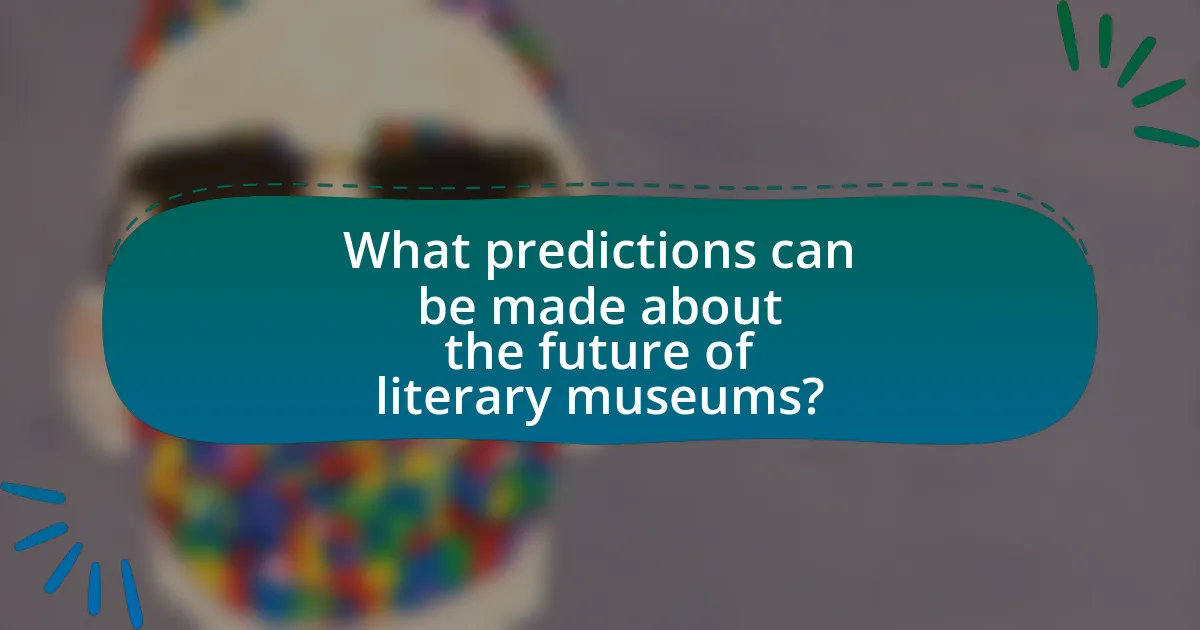
What predictions can be made about the future of literary museums?
Literary museums are likely to evolve into more interactive and digital spaces in the future. This prediction is supported by the increasing integration of technology in cultural institutions, as seen in the rise of virtual reality exhibits and online collections that enhance visitor engagement. Additionally, the trend towards inclusivity and diverse narratives suggests that literary museums will expand their focus to include underrepresented authors and genres, reflecting broader societal changes. Research indicates that museums that adapt to these trends experience higher visitor satisfaction and engagement, as evidenced by a 2021 study from the American Alliance of Museums, which found that 75% of visitors prefer interactive experiences over traditional displays.
How will the role of literary museums evolve in the next decade?
The role of literary museums will increasingly focus on digital engagement and interactive experiences over the next decade. As technology advances, literary museums will adopt virtual reality and augmented reality to create immersive storytelling experiences that attract younger audiences. For instance, the integration of digital archives and online exhibitions will allow global access to literary collections, enhancing educational outreach. Additionally, literary museums will likely collaborate with authors and contemporary artists to host dynamic events and workshops, fostering community involvement and promoting diverse literary voices. This evolution aligns with trends in cultural institutions that prioritize accessibility and innovation to remain relevant in a rapidly changing cultural landscape.
What new educational programs are expected to emerge?
New educational programs expected to emerge in literary museums include digital literacy workshops, interactive storytelling sessions, and interdisciplinary collaborations with technology and art. These programs aim to engage diverse audiences by integrating modern technology into traditional literary education. For instance, digital literacy workshops will focus on teaching visitors how to critically evaluate online literary resources, while interactive storytelling sessions will utilize virtual reality to enhance narrative experiences. Interdisciplinary collaborations may involve partnerships with tech companies to create immersive exhibits that blend literature with digital art, reflecting the evolving landscape of education in the context of literary museums.
How might partnerships with other cultural institutions change?
Partnerships with other cultural institutions may increasingly focus on digital collaboration and shared resources. As technology advances, literary museums are likely to leverage virtual platforms for joint exhibitions and educational programs, enhancing accessibility and audience reach. For instance, the rise of online exhibitions during the COVID-19 pandemic demonstrated how institutions could collaborate remotely, leading to a more integrated cultural experience. This shift towards digital partnerships can also facilitate the sharing of archival materials and expertise, fostering innovation in programming and outreach.
What challenges will literary museums face in the future?
Literary museums will face challenges such as declining visitor numbers, the need for digital transformation, and competition from alternative cultural experiences. Visitor numbers have been decreasing in many cultural institutions, with a report from the American Alliance of Museums indicating that attendance dropped by 30% during the COVID-19 pandemic, highlighting the need for innovative engagement strategies. Additionally, as technology evolves, literary museums must adapt by integrating digital platforms to reach broader audiences, as evidenced by the increasing popularity of virtual tours and online exhibitions. Lastly, competition from diverse entertainment options, including streaming services and interactive media, requires literary museums to enhance their offerings to attract and retain visitors.
How will funding and resources impact their sustainability?
Funding and resources significantly impact the sustainability of literary museums by determining their operational capacity and program development. Adequate funding allows these institutions to maintain facilities, curate exhibitions, and offer educational programs, which are essential for attracting visitors and fulfilling their mission. For instance, a study by the American Alliance of Museums indicates that museums with diversified funding sources, including grants, donations, and ticket sales, are more likely to sustain their operations over time. This financial stability enables literary museums to innovate and adapt to changing cultural landscapes, ensuring their relevance and longevity.
What measures can be taken to address potential declines in visitor numbers?
To address potential declines in visitor numbers, literary museums can implement targeted marketing strategies and enhance visitor engagement through interactive exhibits. Research indicates that museums that actively promote their events and programs through social media and community outreach see a 20% increase in attendance. Additionally, incorporating technology, such as virtual reality experiences or mobile apps, can attract younger audiences and improve visitor satisfaction, leading to repeat visits. For instance, the British Museum reported a 30% rise in visitor numbers after introducing augmented reality features in their exhibits. These measures not only draw in new visitors but also foster a loyal audience base.
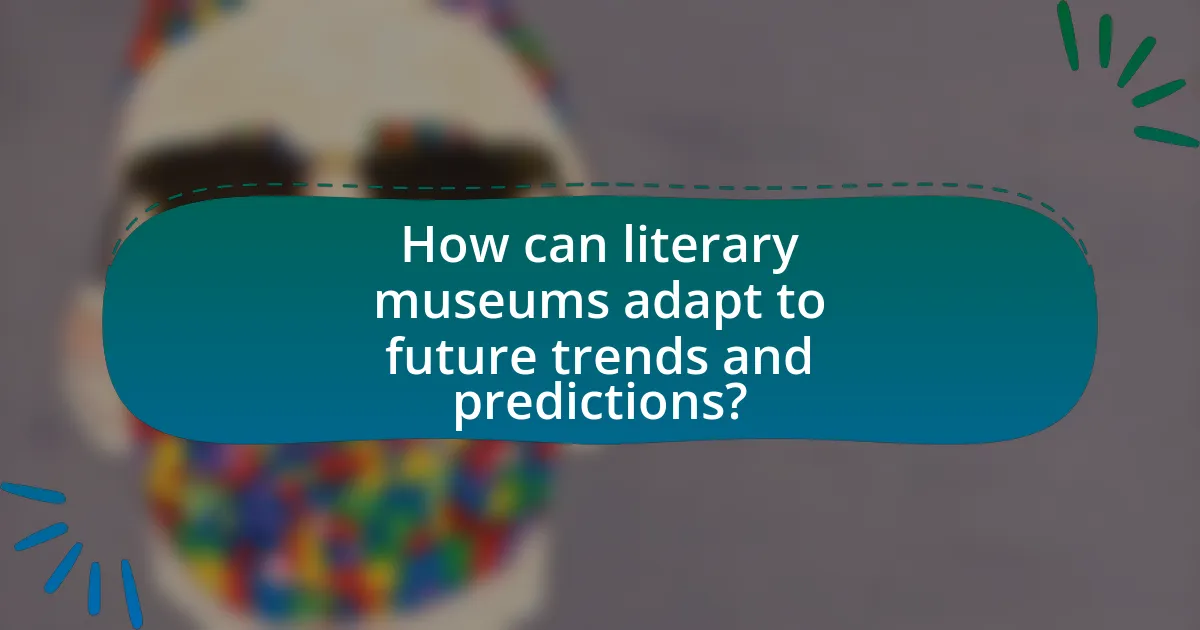
How can literary museums adapt to future trends and predictions?
Literary museums can adapt to future trends and predictions by integrating digital technologies and interactive experiences into their exhibits. This adaptation is essential as studies show that visitor engagement increases significantly when museums utilize augmented reality, virtual reality, and mobile applications. For instance, the American Alliance of Museums reported that institutions employing technology saw a 30% rise in visitor interaction. Additionally, literary museums can expand their outreach through online platforms, allowing global access to their collections and programs, which aligns with the growing trend of virtual experiences in cultural institutions. By embracing these innovations, literary museums can remain relevant and attract diverse audiences in an evolving cultural landscape.
What best practices should literary museums adopt for modernization?
Literary museums should adopt digital engagement strategies, such as virtual tours and interactive exhibits, to modernize their offerings. These practices enhance accessibility and attract a broader audience, particularly younger generations who are accustomed to digital experiences. For instance, the British Museum’s virtual tours have seen significant visitor engagement, demonstrating the effectiveness of digital platforms in reaching diverse audiences. Additionally, integrating social media campaigns can foster community interaction and promote events, as seen with the success of the American Writers Museum’s online initiatives. By leveraging technology and social media, literary museums can remain relevant and engaging in a rapidly evolving cultural landscape.
How can museums leverage social media for outreach and engagement?
Museums can leverage social media for outreach and engagement by creating interactive content that encourages audience participation. This includes hosting live virtual tours, sharing behind-the-scenes footage, and utilizing user-generated content to foster community involvement. For instance, the American Museum of Natural History increased its online engagement by 300% during the pandemic by offering virtual events and interactive posts on platforms like Instagram and Facebook. Additionally, museums can use targeted advertising to reach specific demographics, enhancing their visibility and attracting diverse audiences. By analyzing engagement metrics, museums can refine their strategies to better connect with their communities, ensuring that their outreach efforts are effective and impactful.
What role does audience feedback play in shaping future exhibits?
Audience feedback plays a crucial role in shaping future exhibits by providing insights into visitor preferences and experiences. This feedback allows curators to understand which elements resonate with audiences, leading to more engaging and relevant exhibits. For instance, studies have shown that museums that actively incorporate visitor feedback into their planning process see increased visitor satisfaction and attendance. By analyzing surveys and comments, literary museums can adapt their themes, displays, and educational programs to better align with audience interests, ultimately enhancing the overall impact of their exhibits.
What innovative programming ideas can enhance visitor experiences?
Innovative programming ideas that can enhance visitor experiences in literary museums include interactive storytelling sessions, augmented reality (AR) exhibits, and author-led workshops. Interactive storytelling sessions engage visitors by allowing them to participate in narrative creation, fostering a deeper connection to the literary works. Augmented reality exhibits can bring texts to life by overlaying digital content onto physical displays, enhancing understanding and engagement with the material. Author-led workshops provide unique opportunities for visitors to learn directly from writers, creating a personal and immersive experience that can deepen appreciation for literature. These approaches have been shown to increase visitor satisfaction and engagement, as evidenced by studies indicating that interactive and participatory experiences lead to higher retention and enjoyment among museum-goers.
How can literary museums incorporate interactive elements into their exhibits?
Literary museums can incorporate interactive elements into their exhibits by utilizing technology such as augmented reality (AR) and virtual reality (VR) to create immersive experiences. For instance, AR can allow visitors to see animated scenes from literary works when they point their devices at specific exhibits, enhancing engagement and understanding of the text. Additionally, interactive touchscreens can provide access to author interviews, historical context, and multimedia content related to the exhibits, allowing visitors to explore literature in a more dynamic way. Research indicates that museums that integrate interactive technologies see increased visitor satisfaction and retention, as evidenced by a study published in the Journal of Museum Education, which found that 75% of participants preferred interactive exhibits over traditional displays.
What types of events can foster a deeper connection with literature?
Literary festivals, author readings, and book clubs are types of events that can foster a deeper connection with literature. Literary festivals provide opportunities for audiences to engage with authors, participate in discussions, and explore various genres, enhancing appreciation for diverse literary forms. Author readings allow attendees to hear works directly from the creators, offering insights into the writing process and the themes within the texts. Book clubs encourage communal reading experiences, facilitating discussions that deepen understanding and personal connections to the literature. These events have been shown to increase literary engagement, as evidenced by studies indicating that participation in such activities correlates with higher levels of reading comprehension and enjoyment.
